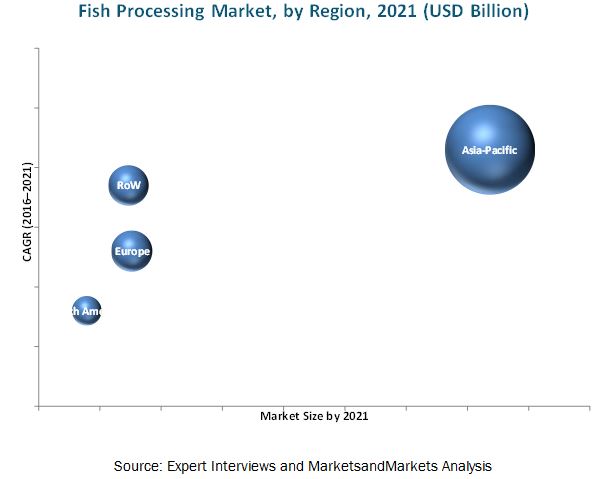Practices › F&B Processing and Technology › Fish Processing Market
Fish Processing Market
The global market for fish processing has been growing steadily during the last few decades. In terms of value, the market is projected to reach USD 222.71 Billion by 2021, at a CAGR of 3.8% from 2016 to 2021 and is projected to reach 37,194.98 KT in terms of volume by 2021, at a CAGR of 2.2%. Factors such as high nutritional profile and added health benefits of processed fish and fish products, growth in the aquaculture industry, and increase in health consciousness toward value-added fish products are driving the fish processing market.
The fish processing market, based on category, is segmented into frozen, preserved, and others (which includes cured, dried, smoked, salted, and surimi). The frozen segment accounted for the largest market share and the others segment (which includes cured, dried, smoked, slated, and surimi) is projected to grow at the highest CAGR during the forecast period as convenience and ready-to-cook attributes the popularity of processed fish products among the middle-aged and younger population.
The fish processing market, based on application, is segmented into food and non-food. The demand for processed fish has been increasing due to various factors such as the diversified portfolio of fish products offered by fish processors & manufacturers and changing eating habits of the population with the inclusion of fish products as a part of their daily diets.
The fish processing market, based on source of capture, is segmented into marine and inland. The marine segment is dominating the market by source due to increase in marine capture rates for both coastal and deep sea fish which are used for processing in most Asian & European countries.
The fish processing market, based on species, is segmented into fish, crustraceans, mollusks, and others (which includes turtles and urchins). The fish segment comprising majorly of whitefish, tuna, and salmon dominate the market by species. The factors which led to the growth of the market include a low-fat and high-quality protein content offered by these fishes and the ease of incorporation into food applications.
The fish processing market, based on equipment, is segmented into slaughtering, curing & smoking, gutting, skinning, scaling, filleting, deboning, and others, which include packing and storing machines. The slaughtering segment dominated the market by equipment as these equipment are corrosion-free and available with various cut types designed for a variety of fishes.

The fish processing market was dominated by the Asia-Pacific region in 2015. It is projected to be the fastest-growing market from 2016 to 2021. Economic growth and the shift of the preferences of the consumers toward value-added processed fish products have led to the market growth in this region. In Europe, countries such as Germany, U.K., France, Italy, Portugal, and Poland have shown increment in the capture rate of marine fish catering to the increased demand for processed fish products.
The increasing prices of raw materials are adversely affecting the fish processing industry. The raw materials used in fish processing are a variety of fishes and other marine products. The prices of these raw materials are rising owing to the increase in the cost of aquaculture. Feed is the main input for any aquaculture and the prices of feed are continuously increasing due to which aquaculture is costly to maintain.
The key players in this market have adopted various strategies to expand their global presence and increase their market share. Partnerships, agreements, collaborations, acquisitions, and new product launches are some of the key strategies adopted by market players to achieve growth in the global fish processing industry. The rising demand for processed fish products as well as high growth rate of fisheries and aquaculture in emerging countries has encouraged companies to adopt these strategies. Market players are focusing on entering into collaborations to share technical know-how related to biotechnology that can improve marine productivity. Charoen Pokphand Foods PCL (Thailand), Maruha Nichiro Corporation (Japan), and Nippon Suisan Kaisha, Ltd. (Japan) are some of the leading market players that adopted this strategy in order to develop their business.
To speak to our analyst for a discussion on the above findings, click Speak to Analyst
